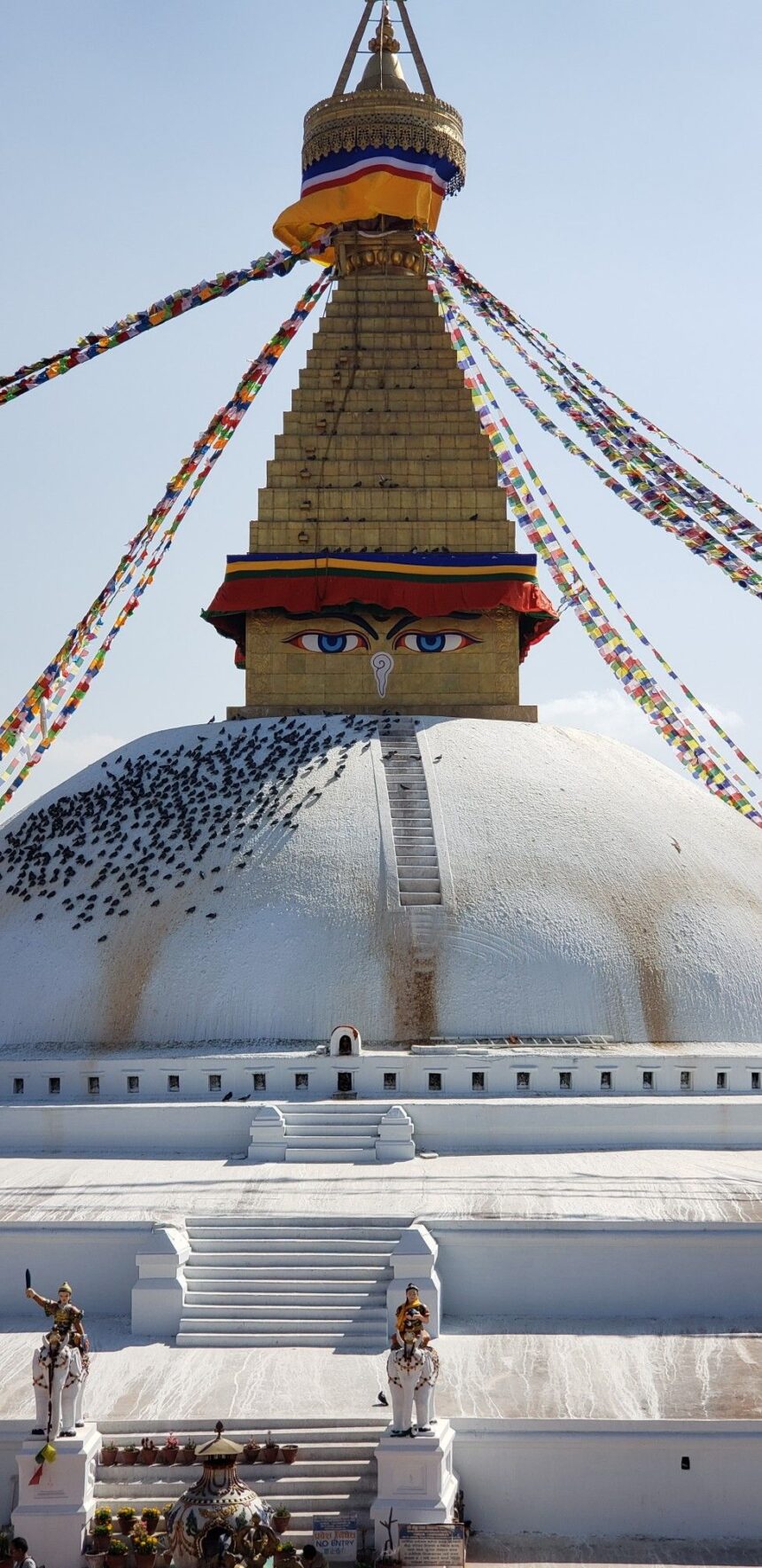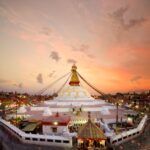Introduction
The Boudhanath Stupa, also called Buddha Stupa, is one of the largest stupas in Nepal and the world. Located in Kathmandu, it is a UNESCO World Heritage Site and a vital spiritual center for Tibetan Buddhism. Known for its towering dome, all-seeing eyes of Buddha, and serene ambiance, the stupa attracts pilgrims, tourists, and spiritual seekers from around the globe.
- Introduction
- History of Boudhanath Stupa
- Fascinating Facts About Boudhanath Stupa
- Timeline of Boudhanath Stupa
- Significance of Boudhanath Stupa
- 1. Religious Significance
- 2. Cultural Importance
- 3. Architectural Value
- 4. Tourism & Economy
- 5. Spiritual & Educational Role
- 6. Peace Symbol
- Observance & Cultural Activities
- Wishing at Boudhanath Stupa
- Daily Life Impact
- FAQs About Boudhanath Stupa
- Important Tips for Visitors
- Importance in Society
- Conclusion
For travelers seeking cheap vacation ideas with cultural and spiritual immersion, Boudhanath Stupa is an ideal destination, offering both tranquility and cultural vibrancy. This guide explores history, fascinating facts, timeline, significance, observance, wishing, FAQs, daily life impact, and societal importance in a human-friendly, immersive style.
History of Boudhanath Stupa
Ancient Origins: The stupa is believed to have been built in the 5th century CE, with legends linking it to King Manadeva’s reign.
Tibetan Influence: With the influx of Tibetan refugees in the 1950s, Boudhanath became a center for Tibetan Buddhism and monasteries.
Restoration: The stupa has undergone restoration multiple times, most recently after the 2015 earthquake, preserving its architectural and spiritual integrity.
Cultural Heritage: Recognized as a UNESCO World Heritage Site in 1979, it is considered one of the holiest Buddhist sites in Nepal.
Fun Fact: The stupa’s white dome and golden spire represent enlightenment and the path to spiritual liberation, making it a symbol of peace and wisdom.
Fascinating Facts About Boudhanath Stupa
Giant Stupa: It is one of the largest spherical stupas in the world, standing at approximately 36 meters high.
All-Seeing Eyes: The stupa features Buddha’s eyes on all four sides of the tower, symbolizing compassion and wisdom.
Prayer Wheels: Surrounding the stupa are hundreds of prayer wheels that devotees spin while walking clockwise.
Monastic Center: Home to numerous Tibetan monasteries (gompas), making it a hub of religious study and practice.
Festival Hub: Central to celebrations of Buddha Jayanti and Lhosar, attracting thousands of pilgrims.
Cultural Diversity: A meeting point for Nepali, Tibetan, and international communities.
Tourist Experience: Popular among tourists for photography, spiritual learning, and immersive cultural experiences.
Timeline of Boudhanath Stupa
5th Century CE: Original construction under King Manadeva or local legends attributing to early Buddhist builders.
14th Century: Flourished as a Tibetan Buddhist center for travelers and traders along trade routes.
1950s: Tibetan refugees establish monasteries, expanding the stupa’s spiritual significance.
2015: Earthquake damages the stupa; restoration preserves its historic and spiritual value.
Present: Serves as a cultural, religious, and tourist hub, attracting thousands annually.
Significance of Boudhanath Stupa
1. Religious Significance
Boudhanath Stupa is one of Nepal’s most sacred Buddhist sites, where pilgrims perform kora (circumambulation) while spinning prayer wheels and chanting mantras.
2. Cultural Importance
It represents the fusion of Newar and Tibetan cultures, preserving art, rituals, and festivals.
3. Architectural Value
The stupa features traditional Buddhist architectural elements: white dome, golden spire, and mandala-inspired design.
4. Tourism & Economy
Supports local businesses, monasteries, cafes, handicraft shops, and guides, contributing to Kathmandu’s economy.
5. Spiritual & Educational Role
Provides learning opportunities about Buddhism, meditation, and Himalayan culture for both locals and international visitors.
6. Peace Symbol
Represents harmony, wisdom, and enlightenment, drawing visitors seeking inner peace and spiritual guidance.
Observance & Cultural Activities
Buddha Jayanti: Celebrates the birth, enlightenment, and death of Buddha with prayers, butter lamps, and circumambulation.
Tibetan New Year (Lhosar): Monks and locals perform rituals, dances, and prayers.
Daily Rituals: Monks chant, light butter lamps, and devotees spin prayer wheels.
Festivals & Events: Cultural performances, religious teachings, and meditation sessions.
Wishing at Boudhanath Stupa
Visitors often make wishes while circumambulating the stupa, spinning prayer wheels, or lighting butter lamps:
🕉️ “May my mind be filled with wisdom, compassion, and clarity.”
🌸 “Wishing for peace, happiness, and spiritual growth for myself and loved ones.”
🏔️ “May this sacred place guide me toward mindfulness and inner harmony.”
These acts connect visitors with Buddhist spiritual practices, enhancing the emotional and cultural experience.
Daily Life Impact
Boudhanath Stupa influences both locals and tourists:
For Tourists: Offers spiritual learning, cultural immersion, photography, and meditation experiences.
For Locals: Supports monks, guides, artisans, and hospitality businesses.
For Society: Promotes heritage conservation, cultural awareness, and community cohesion.
Students and visitors learn about Buddhist philosophy, Nepalese culture, and religious tolerance, fostering personal growth and social understanding.
FAQs About Boudhanath Stupa
Q1: What is the best time to visit?
A: Early morning or late afternoon to avoid crowds and enjoy serene lighting.
Q2: Is there an entry fee?
A: Yes, a nominal fee supports maintenance and preservation.
Q3: Can I take photographs?
A: Photography is allowed, but be respectful of worshippers and monks.
Q4: How long should one spend here?
A: 1–2 hours for a full experience including circumambulation, prayer, and meditation.
Q5: Are guided tours available?
A: Yes, knowledgeable guides explain the history, architecture, and spiritual significance.
Important Tips for Visitors
Dress modestly and respectfully.
Walk clockwise around the stupa while spinning prayer wheels.
Avoid loud talking and maintain a peaceful demeanor.
Respect monks and devotees performing rituals.
Carry water and sun protection for outdoor circumambulation.
Importance in Society
Boudhanath Stupa is a spiritual, cultural, and economic cornerstone in Nepal:
Religious Preservation: Maintains centuries-old Buddhist traditions.
Cultural Significance: Promotes understanding of Newar and Tibetan heritage.
Tourism Economy: Supports local businesses, artisans, and guides.
Educational Role: Offers insights into Buddhism, art, and Himalayan culture.
Community Cohesion: Encourages respect, harmony, and spiritual practice among locals and visitors.
Conclusion
Boudhanath Stupa is not just a monument; it is a living symbol of faith, peace, and cultural heritage. Accessible, serene, and visually mesmerizing, it provides travelers with a deeply spiritual and culturally rich experience.
🕉️ Wishing for You: May your visit to Boudhanath Stupa inspire inner peace, wisdom, and a connection to humanity’s shared spiritual heritage. Let every prayer wheel, butter lamp, and sacred gaze of Buddha guide your journey toward enlightenment and harmony.








